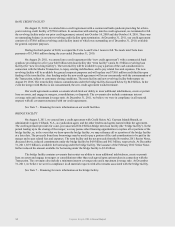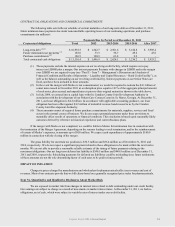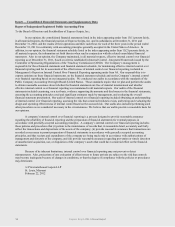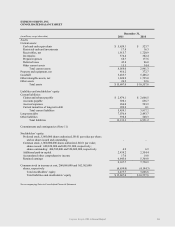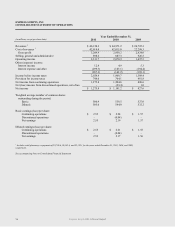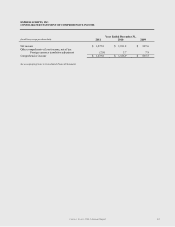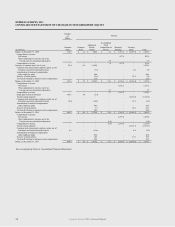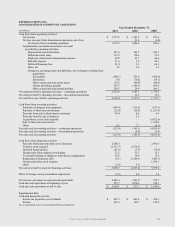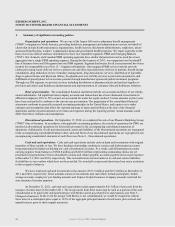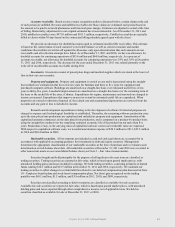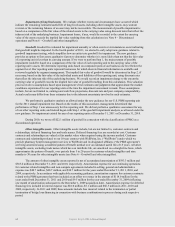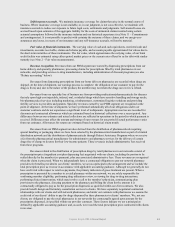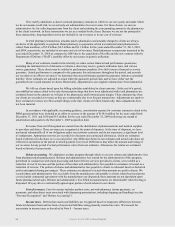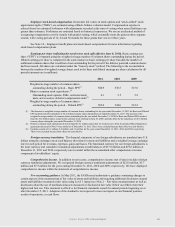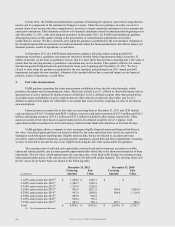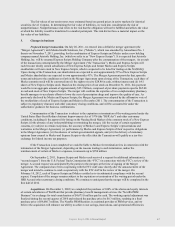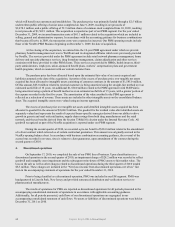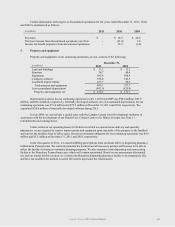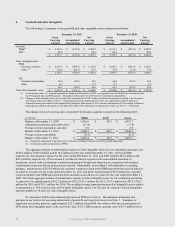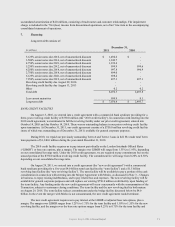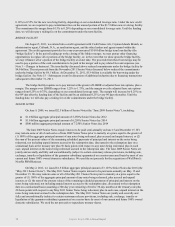Express Scripts 2011 Annual Report Download - page 64
Download and view the complete annual report
Please find page 64 of the 2011 Express Scripts annual report below. You can navigate through the pages in the report by either clicking on the pages listed below, or by using the keyword search tool below to find specific information within the annual report.
Express Scripts 2011 Annual Report
62
Impairment of long lived assets. We evaluate whether events and circumstances have occurred which
indicate the remaining estimated useful life of long lived assets, including other intangible assets, may warrant
revision or the remaining balance of an asset may not be recoverable. The measurement of possible impairment is
based on a comparison of the fair value of the related assets to the carrying value using discount rates that reflect the
inherent risk of the underlying business. Impairment losses, if any, would be recorded to the extent the carrying
value of the assets exceeds the implied fair value resulting from this calculation (see Note 4 – Discontinued
operations and Note 6 – Goodwill and other intangibles).
Goodwill. Goodwill is evaluated for impairment annually or when events or circumstances occur indicating
that goodwill might be impaired. In the fourth quarter of 2011, we elected to early adopt new guidance related to
goodwill impairment testing, which simplifies how an entity tests goodwill for impairment. The new guidance
provides an option to first assess qualitative factors to determine whether it is more likely than not that the fair value
of a reporting unit is less than its carrying amount. If we were to perform Step 1, the measurement of possible
impairment would be based on a comparison of the fair value of each reporting unit to the carrying value of the
reporting unit’s assets. We determine reporting units based on component parts of our business one level below the
segment level. Our reporting units represent businesses for which discrete financial information is available and
reviewed regularly by segment management. The implied fair value of goodwill would be determined in Step 2, if
necessary, based on the fair value of the individual assets and liabilities of the reporting unit, using discount rates
that reflect the inherent risk of the underlying business. We would record an impairment charge to the extent the
carrying value of goodwill exceeds the implied fair value of goodwill resulting from this calculation. This valuation
process involves assumptions based upon management’s best estimates and judgments that approximate the market
conditions experienced for our reporting units at the time the impairment assessment is made. These assumptions
include, but are not limited to, earnings and cash flow projections, discount rate and peer company comparability.
Actual results may differ from these estimates due to the inherent uncertainty involved in such estimates.
We performed a qualitative analysis as allowed under the new guidance for our U.S. PBM reporting unit
for the 2011 annual impairment test. Based on the results of this assessment, management determined that
performance of Step 1 was unnecessary for this reporting unit. We did not perform a qualitative assessment for any
of our other reporting units, and instead began with Step 1 of the goodwill impairment analysis, as allowed under the
new guidance. No impairment existed for any of our reporting units at December 31, 2011 or December 31, 2010.
During 2010, we wrote off $22.1 million of goodwill in connection with the classification of PMG as a
discontinued operation.
Other intangible assets. Other intangible assets include, but are not limited to, customer contracts and
relationships, deferred financing fees and trade names. Deferred financing fees are recorded at cost. Customer
contracts and relationships are valued at fair market value when acquired using the income method. Customer
contracts and relationships related to our 10-year contract with WellPoint, Inc. (―WellPoint‖) under which we
provide pharmacy benefit management services to WellPoint and its designated affiliates (―the PBM agreement‖)
are being amortized using a modified pattern of benefit method over an estimated useful life of 15 years. All other
intangible assets, excluding trade names which have an indefinite life, are amortized on a straight-line basis, which
approximates the pattern of benefit, over periods from 5 to 20 years for customer-related intangibles and nine
months to 30 years for other intangible assets (see Note 6 – Goodwill and other intangibles).
The amount of other intangible assets reported is net of accumulated amortization of $593.3 million and
$383.6 million at December 31, 2011 and 2010, respectively. Amortization expense for our continuing operations
for customer-related intangibles and non-compete agreements included in selling, general and administrative
expense was $40.7 million, $40.7 million, and $34.7 million for the years ended December 31, 2011, 2010, and
2009, respectively. In accordance with applicable accounting guidance, amortization expense for customer contracts
related to the PBM agreement has been included as an offset to revenue in the amount of $114.0 million for the
years ended both December 31, 2011 and 2010 and $9.5 million for the year ended December 31, 2009 (reflecting
one month of amortization subsequent to the December 1, 2009 acquisition date). Amortization expense for deferred
financing fees included in interest expense was $81.0 million, $5.1 million and $66.3 million in 2011, 2010 and
2009, respectively. In 2011 and 2009, these amounts include fees incurred related to the termination or partial
termination of bridge loan financing in connection with business combinations in process during each respective
period.


